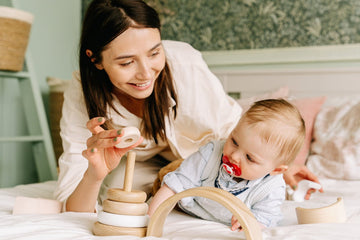As a soon-to-be parent and experienced childbirth educator, I know that aiming for perfection in parenting is unrealistic. Instead, I focus on practical strategies to ease the transition into parenthood while helping others navigate common pitfalls. In this article, I will outline ten key mistakes new parents often make and offer guidance on how to avoid them.
Each of these mistakes can significantly impact the early bonding experience and overall well-being of both parents and the baby. My aim is to share insights that promote smoother early days and foster a healthier parent-child relationship. By making small adjustments and being aware of your baby’s needs, you can create a nurturing environment that enriches your experience and builds a strong foundation for your growing family.
Key Takeaways
Prioritize skin-to-skin contact immediately after birth.
Recognize feeding cues before your baby starts crying.
Be aware of your baby's fatigue signals to ensure better sleep.
Immediate Skin Contact After Birth
Engaging in skin-to-skin contact right after birth is essential for initiating the bonding process between a parent and their newborn. This moment marks the first interaction outside the womb, and it is best if this is done with the mother. Since she is typically the one breastfeeding, this connection feels natural and supports a smoother transition from the womb into the world.
Being skin-to-skin offers numerous benefits for both the baby and the mother. It helps with the baby's emotional and physiological regulation, enhances the establishment of their microbiome by transferring beneficial bacteria, and boosts breastfeeding success. Additionally, this close contact triggers oxytocin release in mothers, aiding in the management of postpartum bleeding.
It's important to practice skin-to-skin contact immediately following birth and continue this practice regularly during the early weeks. Not only does this connection aid in bonding, but it also fosters a supportive environment for the baby’s development.

Swaddling Techniques
Tightly wrapping a baby can become a common practice, especially with hospitals swaddling newborns right after birth. While this may seem like a simple preference, it's essential to think critically about its implications.
Swaddling can restrict a baby's natural reflexes, providing some comfort but potentially hindering the parent-child bond. I’ve noticed that overly tight swaddles may reduce the frequency of feeding since they keep babies from using their hands to explore, which they have relied on for months. If you choose to swaddle, I recommend doing so loosely and allowing hands to remain accessible. This way, the baby can move their arms, promoting development and comfort.
Swaddling should encourage closeness without isolating the baby. The priority is fostering a strong connection and allowing babies to feel secure and comfortable in their new environment.
Discover the vibrant world of Sandilake Clothing, where style meets comfort for your little ones. Our Baby Collection offers adorable outfits crafted with love, ensuring your baby stays cozy and chic.
Recognizing Feeding Cues
As a new parent, it's essential to learn how to identify when your baby is hungry. Babies often display several signs before they begin to cry. Observing these cues can make feeding easier for both you and your child.
Turning their head from side to side
Bobbing their head around
Sticking out their tongue
Eating their fists
Making noises
These actions indicate that your baby is ready to eat. Waiting until they start crying can lead to frustration for both of you, making it harder to achieve a proper latch. When a baby cries, it's their way of expressing their needs. Responding quickly to these signals helps build a strong bond between you and your child.
It's also important to be attentive to your baby’s tired signals to avoid overstimulation. Recognizing when they are rub their eyes, yawn, or appear restless can help you prepare them for sleep. Providing an opportunity for rest will contribute to their overall well-being.
Ultimately, your goal as a parent is to support your baby’s needs, which sets the foundation for a secure, nurturing environment.
Recognizing Signs of Baby Fatigue
As a parent, I know it can be challenging to identify when my baby is tired. Babies express their need for sleep through a variety of signs before they start to cry. These include:
Rubbing their eyes
Yawning
Becoming fidgety or restless
Turning their head from side to side
By paying attention to these cues, I can help my baby settle down for sleep more effectively. Whether it means putting them in a baby carrier, laying them down, or gently shushing them, responding to their tiredness can prevent an overtired baby, who is often harder to soothe.
It's common for life to be busy and for babies to stay awake longer than they should. I strive to tune into those tired signs and act quickly. This proactive approach can make a significant difference in how easily my baby falls asleep and remains peaceful throughout the night.

Managing Your Baby's Sleep Schedule
I want to share some key insights on managing your baby's sleep schedule effectively. Being a new parent comes with its own set of challenges, and understanding your baby’s needs can help smooth the journey.
Firstly, it’s crucial to engage in skin-to-skin contact right after birth. This bonding process not only helps regulate your baby's body temperature and emotions but also supports breastfeeding and encourages the release of oxytocin in mothers. Prioritize this interaction during those early weeks to foster a strong parent-child bond.
Swaddling is another practice that requires careful consideration. While it can seem comforting, tight swaddling may restrict your baby's reflexes, making it harder for them to feed and develop. If you choose to swaddle, do so loosely and allow your baby’s hands to be free, enabling them to explore and self-soothe.
It’s also essential to observe your baby's hunger cues early on. Babies will show signs of readiness for feeding, such as turning their heads or making noises. Responding promptly to these signals makes latching easier, reducing frustration for both you and your baby.
Be attentive to tired signs as well; yawning and rubbing their eyes can indicate it's time for sleep. Creating a calming environment for them to settle can prevent becoming overtired, which is challenging to manage.
When it comes to baby sleep schedules, it's important not to put excessive pressure on yourself. Aim to create a safe and comforting atmosphere where your baby can fall asleep naturally. This approach can alleviate stress surrounding sleep patterns.
Understanding your baby’s dependency is vital. Human infants are particularly reliant on their parents and thrive on quick responses to their needs. By being attentive, you help them feel secure, which is fundamental to their emotional regulation.
To streamline nighttime routines, I found that using a natural skin barrier like lanolin can minimize the need for diaper changes during feedings, thereby allowing both you and your baby to get more rest.
Regarding toys, consider minimizing the use of button toys that require little engagement. Instead, focus on options such as rattles and black-and-white contrast items that stimulate brain development.
Be cautious about introducing solids too early. Stick with breast milk or formula as the primary source of nutrition until around six months. Early introduction can provide empty calories without supporting your baby's growth and development.
Finally, be mindful of electronic devices near your baby. Limiting exposure to these technologies can help support a healthier environment for your little one.

Parental Availability and Response
Being a parent comes with a unique set of challenges, but understanding how to respond to my child's needs can ease the journey. It's crucial to recognize that my baby shows signs of hunger and tiredness well before they cry. I look for cues such as head turning, tongue sticking out, or yawning, which indicate that it's time to feed or soothe my little one.
Responding promptly helps establish a sense of security. Babies are wired to depend on their caregivers, especially in the earliest months. Their need for frequent feedings and close contact means that I should prioritize availability and responsiveness over strict schedules.
Staying attuned to my baby's cues also includes observing their tired signs. For instance, if I notice them rubbing their eyes or becoming restless, I prepare them for sleep. This proactive approach helps avoid an overtired baby, which can make settling down more difficult.
At night, I found it beneficial to minimize disruptions during feeds. Instead of changing diapers repeatedly, I apply a barrier cream to reduce moisture against the skin. This practice allows for quicker feedings and less disturbance for both of us.
Providing a nurturing environment means being present. Whether it’s helping my baby interact with toys that encourage exploration or simply holding them close, every moment counts. Adjusting my approach to meet their needs creates a foundation for healthy development and a strong parent-child bond.
For your growing girl, explore our Girls Collection , featuring playful dresses, trendy tops, and more to suit her unique personality.
Nighttime Diaper Changes
Changing diapers during the night can disrupt both my sleep and my baby's. To make the process smoother, I recommend applying lanolin on my baby's skin. This creates a protective barrier against moisture, which can help minimize the need for frequent changes.
When I do use this method, I also choose to size up my baby's diaper at night. By opting for a slightly larger diaper, I can reduce leaks while allowing for more comfort. Of course, if my baby is uncomfortable or has soiled their diaper, I will change it immediately. By being mindful of these strategies, I can streamline late-night feeding sessions and hopefully get more rest overall.
Steering Clear of Button Toys
I advise against selecting button toys for your little one. These toys require minimal interaction, as children merely press a button to activate lights, sounds, or pop-up features. This lack of engagement doesn’t stimulate cognitive growth and can lead to quick disinterest from the child.
Instead, I found it beneficial to opt for toys that encourage exploration and manipulation. Here are some alternatives I recommend:
Rattles: Simple and effective for auditory exploration.
Mirrors: Great for self-recognition and visual engagement.
High-contrast items: Black and white toys help in visual development.
Balls: Perfect for fostering gross motor skills.
Noise-making toys: These can captivate attention and stimulate curiosity.
For ages 0 to 6 months, I suggest the Lovevery playmat and subscription box, which offer diverse, engaging activities while keeping the toy selection minimal. Keeping the focus on interactive toys will better support your child's development.

Appropriate Moment for Introducing Solid Foods
Starting solids is a crucial milestone in your baby’s development, and timing matters. Many pediatricians may suggest beginning at around four months, but I caution against this. Breast milk or formula is the ideal nutrition for infants during their first year.
Introducing rice cereals too early can lead to a host of issues. These cereals offer minimal nutritional benefits, often filling babies up with empty calories without supporting their immune system, brain development, or gut health. It’s important to note that a baby's digestive system is still maturing at this age; they don’t typically have the necessary enzymes to break down solid foods until they’re about six months old.
Even at six months, the focus should shift from nutrition to exploration and familiarization with food. It's more about letting babies play with and interact with their food rather than providing significant caloric intake. This process sets the stage for healthy eating habits later on.
Use of Electronic Devices Near Baby
Using electronic devices around infants raises concerns regarding their safety and well-being. Devices such as phones, laptops, and tablets emit electromagnetic frequencies that can potentially affect a baby's development. I recommend keeping these devices at a distance to minimize exposure, particularly during critical growth periods.
Infants are particularly sensitive to their surroundings, and I prioritize creating a safe space for them. Electronic devices can distract parents from engaging in essential bonding activities, such as eye contact and responsive interactions that are crucial for developing emotional connections.
Here are some guidelines for managing electronic device use near your baby:
Limit usage: Try to reduce the time spent on devices when you're with your baby.
Create boundaries: Designate specific areas for using electronics away from where your baby plays or sleeps.
Engage fully: Focus on interacting with your baby without distractions, as this supports their social and emotional development.
By being mindful of electronic device use, I aim to foster a nurturing environment that promotes my baby's healthy growth and development.





